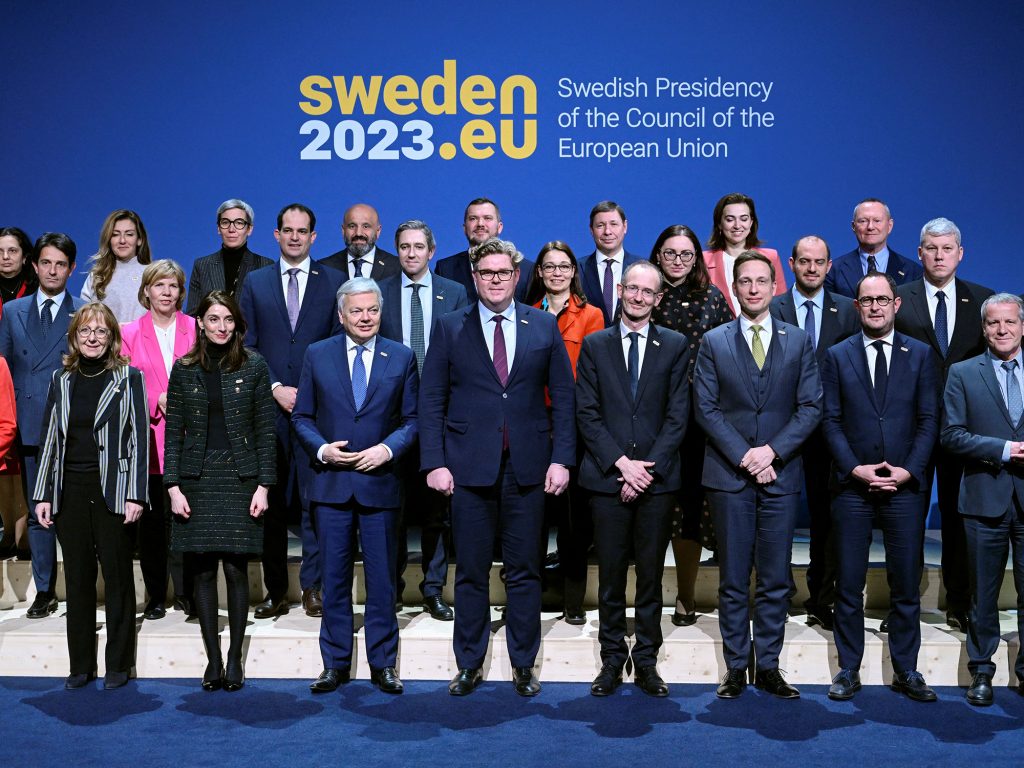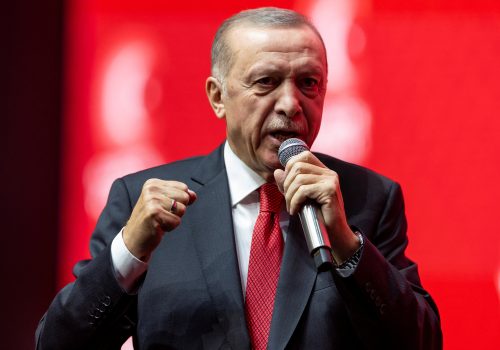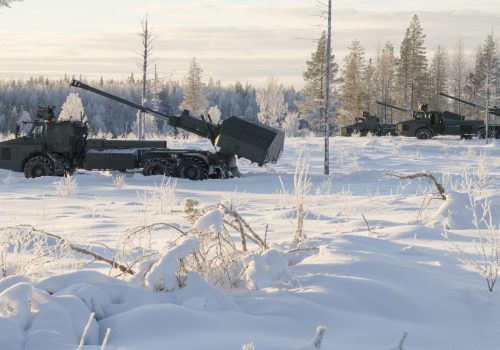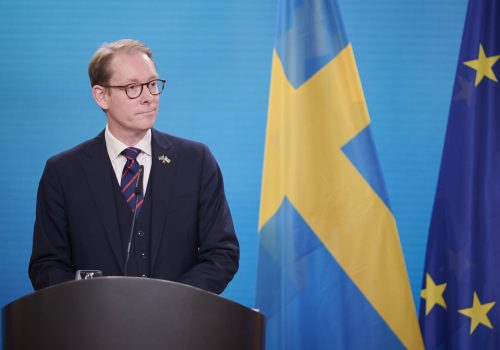Sweden’s decision to undertake NATO membership reflects a monumental change in the European security environment. But while twenty-eight NATO countries have voted to approve Sweden’s accession to the Alliance, the Nordic country’s bid may be in jeopardy. Last week, Turkish President Recep Tayyip Erdoğan told Sweden not to expect “benevolence” for its bid following protests near the Turkish embassy in Stockholm, then on Sunday floated the idea of approving Finland’s NATO membership but not Sweden’s. Whether or not a definitive decision, the Turkish president’s statements highlight how much Sweden’s membership is dependent on Turkey—and Turkey’s decision will likely not be concluded until after the country’s elections in May.
Nonetheless, in the interim, Sweden can significantly add to European security during its presidency of the Council of the European Union (EU)—a role it assumed in January and will hold through June—by ensuring that the EU plays a role, as outlined in the recent Joint Declaration on EU-NATO Cooperation, that complements and reinforces NATO’s actions. Sweden can wield the agenda-setting powers of its presidency to push debate forward on a fully resourced EU security and defense budget directed toward three crucial aims: mobility, sustainment, and critical infrastructure protection. Each of these aims is a prerequisite to defending Europe—but none of them has been adequately achieved yet.
The EU has long asserted the importance of European defense. As EU High Representative for Foreign Affairs and Security Policy Josep Borrell has described, the EU’s history has been “full of plans and initiatives to strengthen the EU’s security and defence policy.” But, he added, “most have come and gone.” Rather, as a comprehensive study by the EU itself concluded, “years of defence underspending… has led to an accumulation of gaps and shortfalls” in the group’s collective military capabilities.
However, following Russia’s invasion of Ukraine last year, European nations have begun taking steps to improve their defense capabilities. The EU itself has provided useful support through its peace facility fund that has backfilled national weapons deliveries to Ukraine, and the EU is in the process of legislating a five-hundred-million-euro fund to support common procurement. But responding to the threat that Russia presents requires much more significant action. Sweden should use its presidency to focus on substantially improving Europe’s capabilities through the establishment of an EU security and defense budget directed toward three key elements of collective defense.
1. Mobility
NATO’s defense against a Russian attack will require moving a large number of NATO forces. According to the NATO Force Model, the Alliance will provide “well over” one hundred thousand forces in under ten days and around two hundred thousand forces between ten to thirty days. Those are very substantial requirements, and NATO needs to ensure that it has the mobility capability to deliver forces in the requisite time frame. With the Alliance’s current capabilities, NATO likely cannot meet those demands.
The deficiencies can be inferred from the EU’s recent “Action plan on military mobility 2.0.” The new plan does recognize that with Russia’s war in Ukraine, the EU has “learned how important it is to move military aid as quickly and smoothly as possible.” But what the plan does not do is describe how well over one hundred thousand forces could be moved in under ten days, nor how around two hundred thousand forces could be moved in ten to thirty days—though this is what the new NATO Force Model requires.
Sweden should ensure that the EU’s implementation of the new military mobility action plan is, in the words of Borrell, “result-oriented and avoid[s] our usual European tendency to go for conceptual or institutional discussions.” Achieving the necessary results will, first and foremost, require sufficient funding.
In the context of the original mobility plan, the European Commission proposed a budget of approximately 6.5 billion euros. However, that proposal was reduced to 1.69 billion euros in the enacted budget, far from what would have been necessary prior to Russia’s invasion of Ukraine and even less so now. The new action plan does not remedy this deficiency, stating only that the Commission will “consider” strengthening the military mobility budget “within the overall review of priorities in the mid-term review of the Multiannual Financial Framework.” Yet given the changes in the security environment, even the 6.5 billion number would be inadequate. Sweden should utilize its presidency to build a consensus that the budget will be revised substantially upward to support what will be necessary to meet the requirements of the NATO Force Model.
2. Sustainment
Here too, adequate resources will be critical. The Russian war in Ukraine has underscored that a European defense against a Russian attack could result in an extended conventional conflict. But for European forces to be able to effectively engage in such a conflict, the EU will need to close what it called one of the “most urgent capability gaps”—inadequate stockpiles of military equipment. While resupplying those stockpiles, the EU should ensure that they include anti-armor capabilities and man-portable and medium-range air defenses, unmanned aerial vehicles for both sensing and attack, long-range fires, and precision-guided munitions.
Nations are increasing their own spending, but the EU has the fiscal capability to provide complementary resources—though the currently planned five-hundred-million-euro fund for common procurement is far from sufficient. Sweden should advocate to include a sustainment initiative in the EU security and defense budget that will provide complementary resources to nations so that they have the conventional capabilities required for an extended conflict.
3. Resilience of critical infrastructure
The EU recently issued important directives requiring that nations enhance the resilience of their critical infrastructure—one set of directives focused on cybersecurity and the other on physical threats. But implementing the directives will require significant fiscal expenditures. For example, the cybersecurity directive tells nations to adopt “cyber hygiene practices” such as “zero-trust principles, software updates, device configuration, network segmentation, identity and access management.” Similarly, the directive tasks national computer security incident response teams with “incident handling”—not an insignificant job during conventional conflict, as shown by the efforts needed to respond to Russian cyber attacks on Ukraine. Accordingly, to achieve the required levels of cybersecurity, Sweden should advocate for a budget that provides complementary fiscal support for following the new directives, rather than leaving those responsibilities solely to nations.
The Russian invasion of Ukraine has required Europe to change the way it approaches security and defense, amounting to what German Chancellor Olaf Scholz calls a Zeitenwende—a turning point. That Zeitenwende applies just as much to the EU as it does to Germany. Contending with the new demands of Europe’s security architecture will require establishing an EU security and defense budget that supports mobility, sustainment, and resilience. Sweden’s presidency can help the EU achieve that goal.
Franklin D. Kramer is a distinguished fellow and a board member of the Atlantic Council. He is a former US assistant secretary of defense for international security affairs.
Further reading
Fri, Jan 27, 2023
What Turkey really wants from Sweden
New Atlanticist By Rich Outzen
Turkey likely will still approve Sweden's bid for NATO membership, but not until summer and only after President Recep Tayyip Erdogan gets more cooperation against the PKK.
Fri, Jan 6, 2023
How allied Sweden and Finland can secure Northern Europe
Issue Brief By
NATO is approaching its ninth round of enlargement. The accession of Sweden and Finland—two solid democracies and defenders of the international-rules based order—into the Alliance will strengthen the core of the transatlantic community.
Wed, Dec 7, 2022
The new Swedish government’s agenda for its EU presidency: Forging unity on Ukraine, defense, and trade
New Atlanticist By Katherine Golden
Swedish Minister of Foreign Affairs Tobias Billström explained Wednesday at an Atlantic Council Front Page event that the EU needs strengthening on several fronts to face the challenges ahead.
Image: Ministers pose for a family photo during the second day of the first informal ministerial meeting in Stockholm, Sweden, January 27, 2023. TT News Agency/Jessica Gow via REUTERS.




